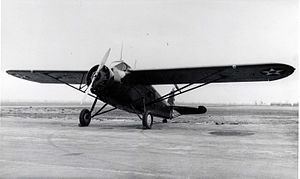Top speed 217 km/h Length 12 m Manufacturer Fairchild Aircraft | Wingspan 17 m First flight 1930 Designer Virginius E. Clark | |
 | ||
The Fairchild 100 was a single engined monoplane with high-mounted wings and was the continuation of a series of utility transport aircraft built by Fairchild Aircraft.
Contents
Design and development
The 100 was similar in design to the Fairchild C-8 and was basically an enlarged version of it.
The first flight of the aircraft (NC754Y) was October 22, 1930. Although only one aircraft was completed, a modified version also known as the Pilgrim 100-A was in production for American Airways, the first operator of the type in 1931. After a total of 16 aircraft, an additional batch of ten aircraft with a larger fin were manufactured by the restructured American Aircraft & Engine Corporation that emerged in 1931 from the Fairchild Aircraft Co. The continuing series was built under the designations, Pilgrim 100-B and American/Fairchild Y1C-24. The first six in the new series went to American Airways. The parent company later reinstated the Fairchild name.
Operational history
The sturdy Fairchild 100 series served as both an airliner and a bush plane. In 1932, the US Army Air Corps bought four Pilgrim Model 100-Bs designated the Y1C-24 and were initially assigned as light cargo transport and supply aircraft.
After a short time in service, the Y1C-24s were adapted for use as aeromedical evacuation aircraft, carrying up to four litter patients. The aircraft were assigned to pilot training and pursuit aircraft airfields for use as crash rescue aircraft. Exploiting the Y1C-24's ability to take off and land in a relatively short distance, the Y1C-24s remained in service into the late 1930s when they were replaced by newer air ambulance aircraft.
Variants
Survivors
Pilgrim 100-B N709Y is one of a few surviving aircraft from the early days of aviation in the history of Alaska. At the time of its listing on the National Register of Historic Places in 1986, it was the last Pilgrim that was still flightworthy. It is now in the collection of the Alaska Aviation Heritage Museum.
Specifications (Y1C-24)
Data from United States Military Aircraft since 1909
General characteristics
Performance
